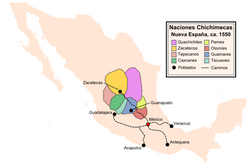Mexican and Central American antiquities, calendar systems, and history; (1904) (14781442685)
Identifier: mexicancentralamer00bowd (find matches)
Title: Mexican and Central American antiquities, calendar systems, and history;
Year: 1904 (1900s)
Authors: Bowditch, Charles P. (Charles Pickering), 1842-1921 Seler, Eduard, 1849-1922 Förstemann, Ernst Wilhelm, 1822-1906 Schellhas, Paul, b. 1859 Sapper, Karl, 1866-1945 Dieseldorff, Erwin Paul, 1868-1940 Wesselhoeft, Selma Parker, Alberta M Thomas, Cyrus, 1825-1910
Subjects: Mayas Maya calendar Calendar, Mexican
Publisher: Washington, Govt. print. off.
Contributing Library: Getty Research Institute
Digitizing Sponsor: Getty Research Institute
View Book Page: Book Viewer
About This Book: Catalog Entry
View All Images: All Images From Book
Click here to view book online to see this illustration in context in a browseable online version of this book.
Text Appearing Before Image:
from which it would seemthat there the god Xipe, the flayed one , received special wor-ship. In fact, a number of characteristic Xipe representationsfrom Teotitlan del camino have found their way into the collec-tions, together with representations of the rain god. The EoyalMuseum of Ethnology in Berlin possesses a beautiful large potteryimage of Xipe, which Professor Felix obtained in Teotitlan del cam-ino. But, during my stay in that place, I found most frequentlycomplete figures and fragments of a deity distinguished by a white » Work cited, chap. 53. & Historia de Yucatan, Devocionario de Nuestra Sefiora de Izmal, Valladolid, 1633,la. part 7, chap. 4. Compare lohue, plumas, las 6rdenes dellas que tienen lospapagallos en si (feathers,the kinds thereof that parrots have on them); Lohue-yache, las amarillas (the yel-low) ; Lohu&-yaa, las azules (the hlue) ; Lohue-naxiilaa, L. huijta, las coloradas(the red) (Juan de Cordova, Vocabulario).Decada III, book 3, chap. 18, p. 102.
Text Appearing After Image:
seler) DEITIES AND RELIGIOUS CONCEPTIONS 297 design resembling a butterfly about the mouth, whose face, paintedin many colors, looks out of the open jaws of a bird with a talland erect crest. We succeeded in bringing home a complete spec-imen of this sort, which is now in the Royal Museum of Eth-nology in Berlin, and a copy of this (front and side views) is givenon plate xlii, reproduced by photographic process. The worshipof this deity, who, in character is evidently identical w^ith the idol ofthe Zapotec Teotitlan del valle, seems to have been remarkably wide-spread. Countless stone images of this deity, of whose birds-headmask only the towering crest remained, have been found in the moun-tains of the slope toward the coast of the Gulf of Mexico, in thosestrips of territory which succumbed to the so-called Chichimec inva-sion, the expansion of the higliland Nahua tribes. In the capital,Mexico, this deity Avas known under the name of Macuil-xochitl, 5 floAver and was regarded as the
Note About Images
Relevantní obrázky
Relevantní články
ČičimékovéČičimékové byli etnická skupina Indiánů ze severního Mexika a Texasu, která ve 12. – 13. století několikrát vpadla do Mezoameriky. Na Anahuackou planinu přišli kolem roku 1170 a pod vedením panovníka Xolotla tam založili říši. Říše Čičiméků pak vzkvétala až do 15. století, kdy Čičimékové splynuli s Aztéky. .. pokračovat ve čtení

